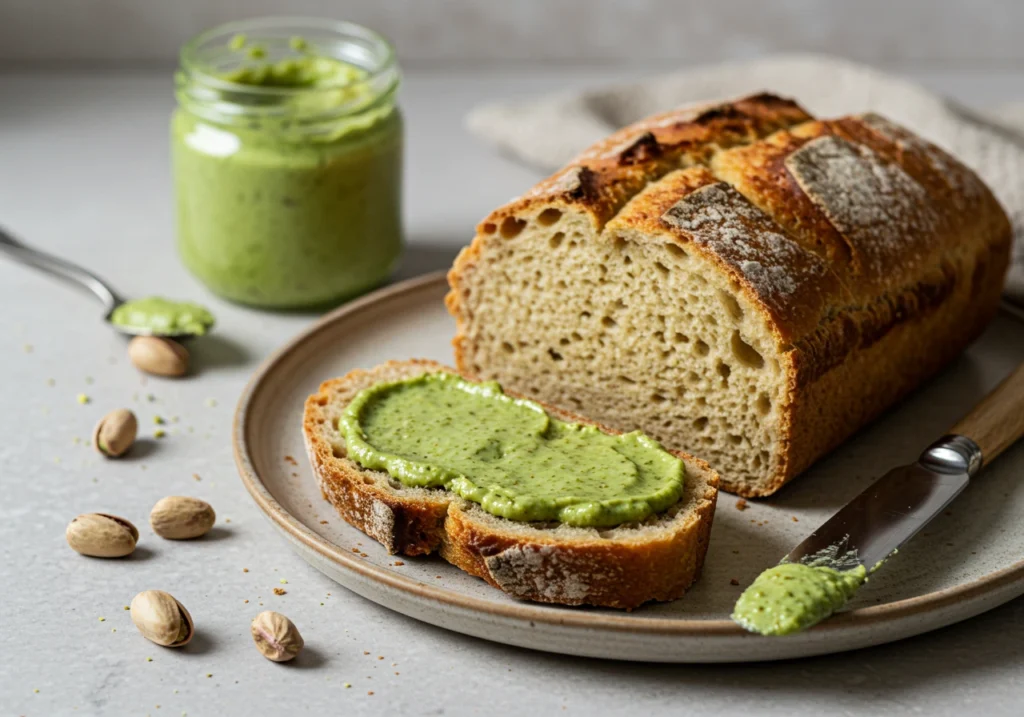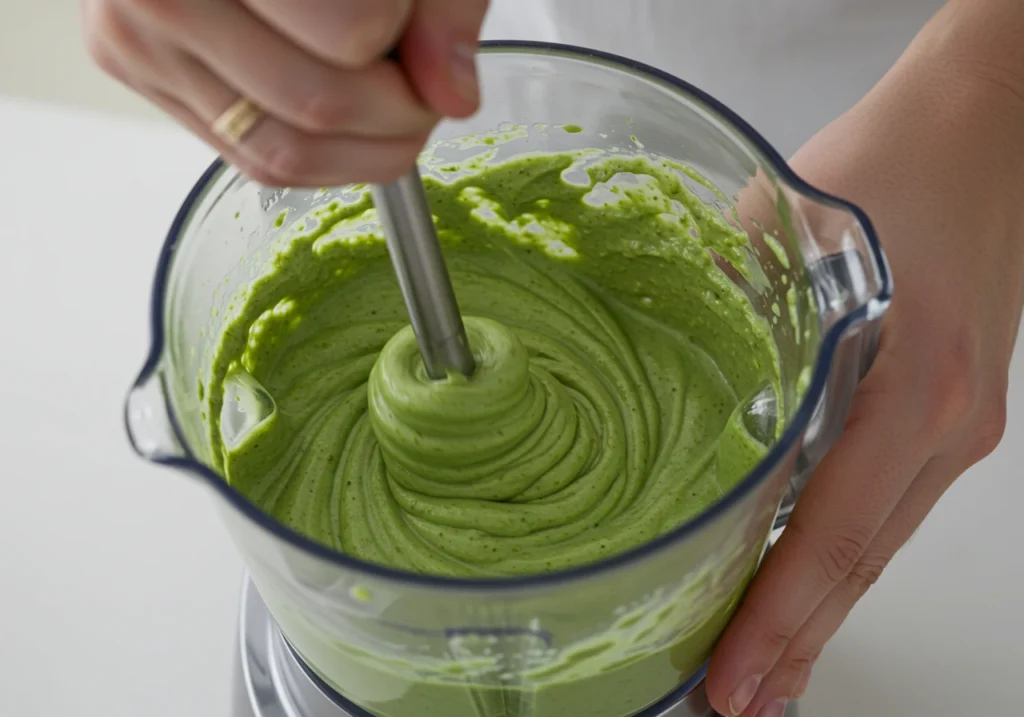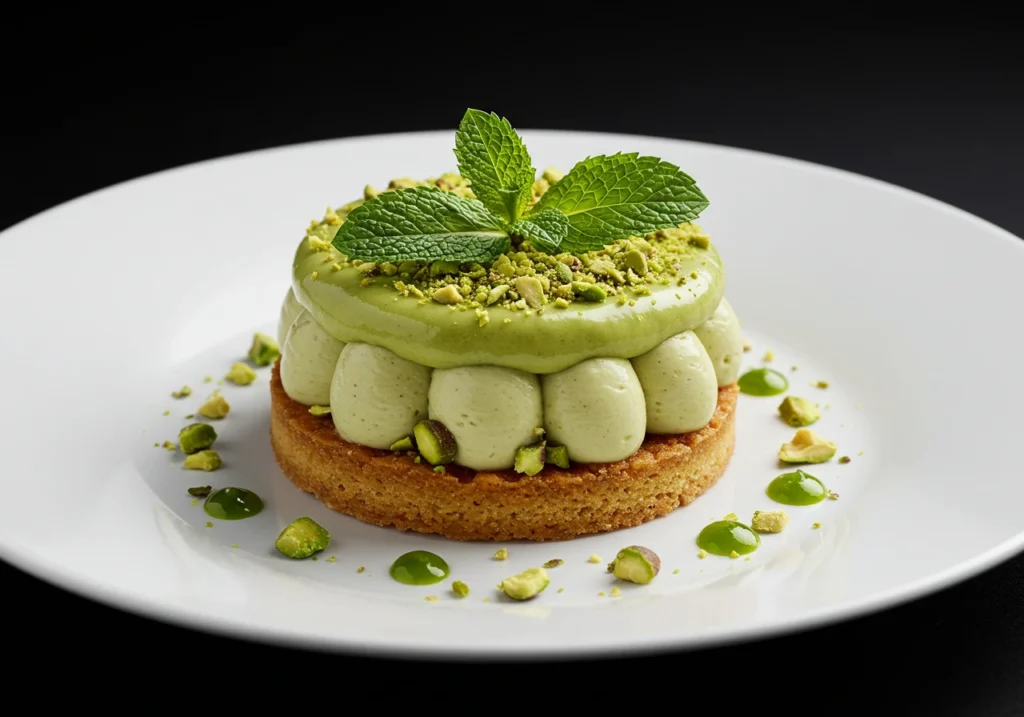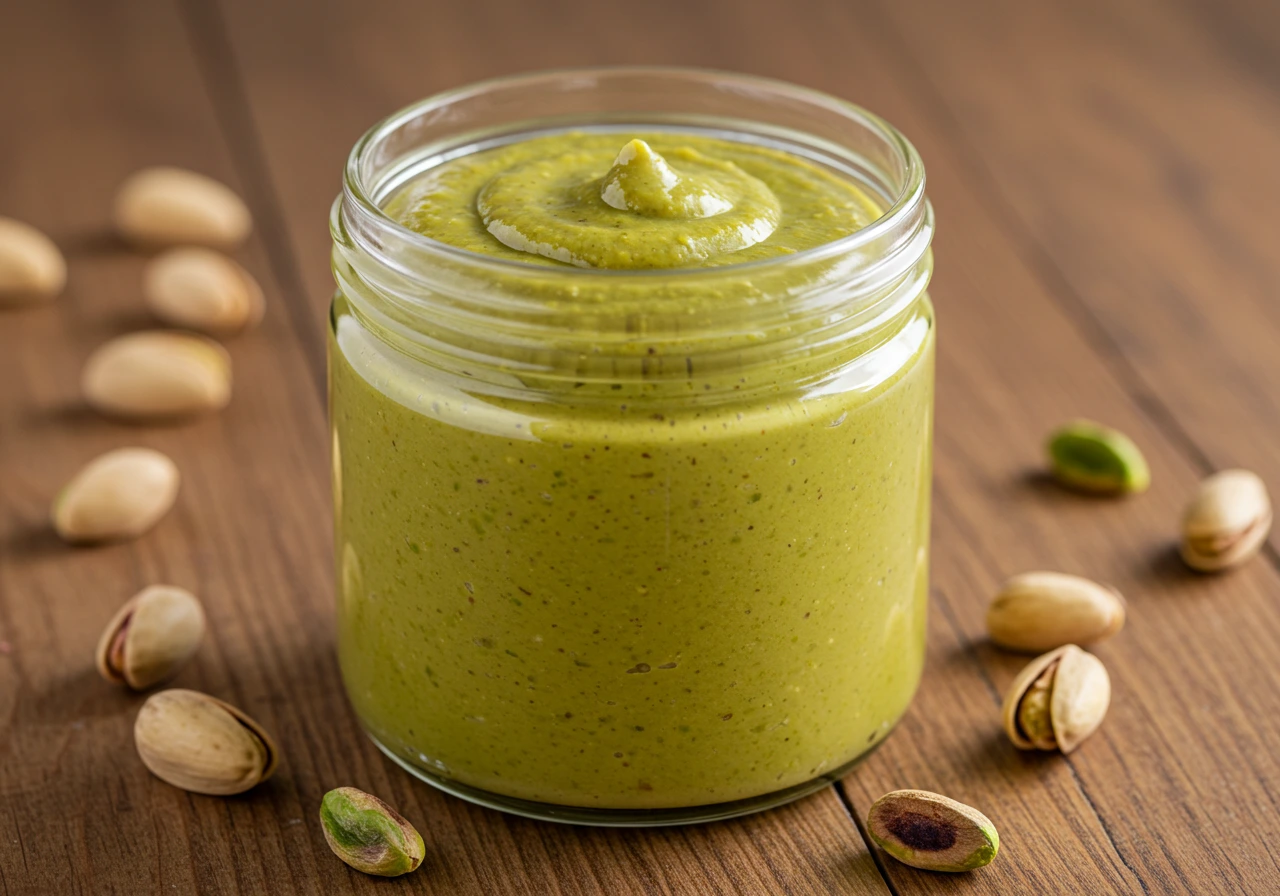Before we dive spoon-first into this luxurious green treasure, let me just say this: I’ve made this pistachio cream recipe with my own two hands—and folks, it’s divine. Silky smooth, delicately sweet, and positively addictive, this nutty spread has transformed my breakfasts, desserts, and honestly… my entire snack game.
This ultimate guide is more than just a recipe—it’s a full-flavored journey from sourcing the finest pistachios to storing your homemade gold. Whether you’re a passionate home cook, a curious foodie, or a dessert aficionado looking to impress, this piece is crafted with love, SEO precision, and yes—firsthand experience.
Part 1: What is Pistachio Cream?
Understanding the Creamy, Nutty Goodness Behind the Trend
Pistachio cream, often dubbed as “green gold,” is a rich, velvety spread made primarily from ground pistachios, a sweetener, and a creamy base like white chocolate or butter. Unlike pistachio butter (which is just blended nuts), this luscious cream leans into dessert territory, offering an indulgent, pastry-worthy experience.
Originating from Italy—Sicily, to be specific—crema di pistacchio has become a culinary icon in European and Middle Eastern kitchens. You’ll find it oozing from croissants, hidden in decadent gelato, or simply dolloped on warm toast.
But what truly sets it apart? It’s the smooth-as-silk texture and vibrant flavor that balances nuttiness with a subtle sweetness. When made right, it’s a luxurious alternative to hazelnut spreads like Nutella. And here’s the kicker—it’s way easier to make than you’d expect.

Why pistachio cream recipe Is More Than a Trend
Beyond its viral fame on social media, pistachio cream has substance. Thanks to pistachios’ naturally high fat content and unique flavor profile, the result is an ultra-smooth texture with a buttery mouthfeel that’s hard to match.
Not to mention, pistachios are nutritional powerhouses—full of fiber, antioxidants, and heart-healthy fats. So hey, while we’re indulging, at least we’re nibbling on something packed with benefits. Right?
How It Differs From Pistachio Paste or Butter
Let’s clear up some confusion—because terms like pistachio paste, pistachio butter, and pistachio cream often get tossed around interchangeably. Here’s how they stack up:
| Product | Ingredients | Use Case | Texture |
|---|---|---|---|
| Pistachio Paste | 100% ground pistachios | Baking, gelato, pastry filling | Thick, dense |
| Pistachio Butter | Pistachios + oil (sometimes) | Spreads, snacks, smoothies | Nutty, gritty |
| Pistachio Cream | Pistachios + sugar + white chocolate | Desserts, drizzling, breakfast spreads | Smooth, creamy |
So, if you’re chasing a dessert-friendly spread that melts in your mouth, pistachio cream recipe is your golden ticket.
Where You’ll Commonly Find Pistachio Cream
You’re most likely to spot this creamy green magic in:
- Italian bakeries and gourmet shops
- High-end gelaterias (where it’s sometimes the star flavor!)
- Fancy brunch menus featuring pistachio cream-topped pancakes
- Pâtisseries across France and Lebanon—hello, pistachio mille-feuille!
But here’s the exciting part—after learning this recipe, you won’t need to go hunting. You’ll own the secret.
I Tried This Pistachio Cream Recipe – And Here’s What Happened
Alright, storytime. When I first made this spread at home, I honestly expected a struggle. But to my surprise, the process was easy-peasy and incredibly satisfying. The kitchen smelled like toasted pistachios and vanilla, and the end result? A jar of silky-sweet, nutty heaven that didn’t last the week.
And if you’re still wondering whether it’s worth the time—let me just say this: my family now requests it weekly. So buckle up, because in the next part, we’ll explore every single way to use this magical concoction.
Part 2: Understanding Pistachio Cream
What is Pistachio Cream?
Pistachio cream is a silky, sweet, and irresistibly nutty spread made from blended pistachios, sugar, and either white chocolate or butter to create its signature luscious texture. It’s not just a spread—it’s an experience. Popular in Mediterranean and Middle Eastern kitchens, this creamy delicacy has roots deeply planted in Sicilian culinary traditions, where pistachios are prized for their intense flavor and vivid green hue.
Unlike its savory cousin, pistachio butter, pistachio cream recipe is made for indulgence. The goal isn’t just to highlight the nut—it’s to elevate it with sweetness and richness. Authentic Italian versions often use Bronte pistachios, renowned for their deep aroma and vibrant green color.
What truly makes pistachio cream unique is its versatility. Whether served as a drizzle, a spoonful, or a dollop, it brings richness to any dish it touches. And, honestly, once you try it, it’s hard not to imagine putting it on everything.
How Does It Compare to Other Nut-Based Spreads?
At first glance, pistachio cream might seem like just another member of the nut spread family. But hold up—let’s break it down:
| Spread Type | Key Ingredient | Texture | Best Use Cases |
|---|---|---|---|
| Almond Butter | Almonds | Thick, grainy | Savory dishes, smoothies, snacks |
| Peanut Butter | Peanuts | Dense, sticky | Sandwiches, cookies, sauces |
| Pistachio Cream | Pistachios + sugar | Silky, dessert-like | Pastries, desserts, toast, spoonful joy |
| Hazelnut Spread | Hazelnuts + cocoa | Chocolatey-smooth | Breakfast spreads, dessert fillings |
While nut butters tend to be thicker and oilier, pistachio cream stands out with its decadent consistency and sweet finish. It doesn’t fight for attention—it melts into whatever dish you pair it with.
And guess what? You don’t even need to buy it from a fancy gourmet store. You’ll soon be making your own right at home—no preservatives, no weird additives, just pure pistachio bliss.
Culinary Uses of Pistachio Cream
One of the things I absolutely adore about pistachio cream recipe is how versatile it is. It’s not one of those one-hit-wonder spreads that you use once and forget. Oh no—it becomes your secret weapon in the kitchen.
As a Spread or Topping
First up, the obvious choice: slather it. Spread that creamy dream on:
- Toast: Classic. Add sliced strawberries or bananas on top, and you’ve got yourself a five-star breakfast.
- Pancakes: Drizzle it between stacks or over the top with a light dusting of powdered sugar.
- Waffles: A generous spoonful nestled in the pockets of a crisp waffle? Chef’s kiss.
It melts slightly from the warmth, creating a blend of gooey and crunchy that’s simply addictive.
In Desserts and Pastries
Here’s where pistachio cream recipe really shines—it’s a baker’s dream. Use it to:
- Fill croissants or brioche buns for a French-Italian fusion morning treat.
- Pipe it inside doughnuts, turning a simple pastry into a gourmet delight.
- Layer it between cakes, especially when paired with vanilla, citrus, or berry flavors.
You can even swirl it through brownie batter or dollop it over panna cotta. The subtle nuttiness adds depth and sophistication to every bite.
Incorporation into Beverages
Okay, now let’s talk next-level creativity.
- Coffee Lattes: Stir a spoonful into a hot latte for a nutty, slightly sweet pick-me-up.
- Milkshakes: Blend it with vanilla or banana for a creamy, gourmet twist.
- Hot Chocolate: Yep, you read that right. Add pistachio cream recipe to hot cocoa and thank me later.
Part 3: Ingredients and Equipment
Essential Ingredients for Pistachio Cream
Crafting a dreamy pistachio cream recipe starts with choosing the right ingredients. Sure, technique matters—but honestly, if your ingredients aren’t top-notch, your cream won’t sing. Let’s break down each component and what role it plays in creating a spoon-worthy spread that’s as smooth as silk and rich with flavor.

Selecting Quality Pistachios
This one’s non-negotiable. The heart of any pistachio cream recipe is—you guessed it—pistachios. But not just any kind.
Opt for raw, unsalted pistachios. Why? Because roasted or salted varieties carry extra oils, sodium, and flavor complexities that can overpower your cream or mess with its texture. Plus, raw pistachios give you the power to roast them lightly at home, unlocking a toasty aroma without bitterness.
If you’re feeling a little fancy, hunt down Sicilian Bronte pistachios. They’re sweet, vibrant, and almost neon green—ideal for that striking, Instagrammable hue. But even standard raw pistachios from your local store can do wonders if handled with love.
Pro tip: Always check for freshness. Rancid nuts = bitter, musty pistachio cream. Nope, not today.
Sweeteners and Flavor Enhancers
Here’s where the magic kicks in.
- White chocolate isn’t just about sweetness—it adds a luscious creaminess that balances the nutty flavor while giving the spread that irresistible melt-in-your-mouth vibe.
- Powdered sugar is preferred over granulated sugar because it dissolves seamlessly, ensuring a velvety texture. You can adjust this to taste—less for a mild flavor, more if you’re leaning dessert-style.
- Vanilla extract (pure, please) deepens the flavor and gives your cream that gourmet edge. Some even toss in a pinch of sea salt to balance the sweetness—yes, just a pinch!
Optional but divine: a splash of orange blossom water or a touch of cardamom for a subtle Middle Eastern twist.
Fats and Oils
Now let’s talk silkiness. You need fat to bring it all together.
- Unsalted butter is the classic choice. It enhances richness while allowing the pistachio flavor to shine.
- Want to go dairy-free? Avocado oil or light olive oil works beautifully. Choose a neutral-tasting oil to avoid overpowering the star ingredient.
- For added gloss and spreadability, some even blend in a spoonful of coconut oil. It solidifies slightly when cool, giving your cream a stable, spoonable texture.
No matter what fat you use, remember: balance is everything. You want creaminess, not greasiness.
Necessary Kitchen Equipment
Alright, your ingredients are ready to roll—now let’s gear up. You won’t need a professional bakery setup, but a few key tools make all the difference between gritty disappointment and creamy heaven.
Blenders and Food Processors
The real MVP of pistachio cream recipe making is your blender or food processor.
High-powered machines like Vitamix or a robust food processor can transform pistachios into a smooth paste in minutes. Start slow and scrape down the sides often—this ensures every bit gets ground evenly. A weaker processor might work, but you’ll need patience and a little more oil to compensate.
If you’re aiming for commercial-level silkiness, go for a blender with a tamper tool—it helps press the mixture down as it churns.
Additional Tools
These may seem basic, but trust me—they matter:
- Measuring cups and spoons for nailing the right balance between sweeteners and fats.
- A spatula to scrape down the processor bowl and get every luscious bit into your jars.
- Glass jars or airtight containers to store your final masterpiece. Go for wide-mouthed jars—they’re easier to fill and clean.
Optional bonus: a fine mesh strainer if you want an ultra-smooth finish (though with good blending, you may not need it).
Part 4: Step-by-Step Recipe Guide
Welcome to the fun part—making your very own pistachio cream recipe from scratch! If you’ve ever been intimidated by the thought of whipping up a nut-based spread at home, don’t be. With a few smart steps and a little kitchen love, this velvety green goodness will come together easier than you think.
Let’s roll up those sleeves and dive into the process!
Preparing the Pistachios
This stage lays the foundation for flavor and texture. Trust me—don’t rush it.

Shelling and Blanching
First things first: get those raw, unsalted pistachios out of their shells. It’s a bit meditative, honestly. Once you’ve gathered about a cup of shelled pistachios, it’s time to blanch them.
Why blanch? Removing those papery brown skins gives your pistachio cream recipe a vibrant color and silkier texture. Here’s how:
- Boil water in a small saucepan.
- Add the pistachios and let them soak for 1–2 minutes.
- Drain and immediately transfer them to a bowl of cold water.
- Now, rub the pistachios gently between a kitchen towel or your fingers—those skins will slip right off!
This step takes some time, but it’s absolutely worth it.
Roasting for Enhanced Flavor
Want a deeper, nuttier punch? Lightly roast your blanched pistachios.
Spread them out on a baking sheet and toast at 320°F (160°C) for 8–10 minutes. Keep an eye on them—they go from golden to burnt fast.
This step intensifies the pistachio flavor without overwhelming it, and it draws out natural oils that help create pistachio cream recipe that ultra-creamy consistency later on.
Pro tip: Let them cool before blending to avoid melting your blender motor or unbalancing the mixture.
Combining Ingredients
Now comes the alchemy—melding pistachios with sweetness and fat to create pure decadence.
Melting White Chocolate and Butter
In a small saucepan, combine about ½ cup of white chocolate and 2 tablespoons of unsalted butter. Heat on low, stirring constantly.
⚠️ Important: Do not let it boil. White chocolate burns easily, turning grainy or bitter. Use a double boiler if possible or remove the pan from heat intermittently while stirring.
Once melted, stir in a teaspoon of pure vanilla extract. This fragrant combo will be your pistachio cream’s flavor anchor.
If you’re going dairy-free, melt 1½ tablespoons of neutral oil with the chocolate instead of butter.
Blending to Perfection
Now toss your prepared pistachios into a high-speed blender or food processor. Begin by pulsing until a coarse meal forms.
Gradually add in your melted chocolate mixture while blending. This is where the magic happens.
- Scrape the sides often to keep everything even.
- If it looks dry or stiff, drizzle in a bit more oil or milk—just a teaspoon at a time.
- Blend for several minutes until your spread is smooth and creamy.
Keep going until it flows like honey. It might take 5–7 minutes, depending on your machine.
Your kitchen will smell like heaven by this point—rich, nutty, sweet, and warm.
Adjusting Flavor and Consistency
So you’ve blended your pistachio cream, but maybe it needs a little tweak. No worries—we’re in fine-tuning mode now.
Sweetness Levels
Want it sweeter? Add a tablespoon of powdered sugar and blend again.
For a less sugary, more robust flavor, cut back on the white chocolate next time and increase the nuts. It’s totally customizable—just taste as you go!
Optional additions for creative twists:
- A pinch of sea salt to cut sweetness.
- A drop of almond extract for complexity.
- Even a sprinkle of cardamom or orange zest if you’re feeling fancy.
Consistency Modifications
Depending on how you plan to use your pistachio cream, you might want to adjust the thickness.
- Too thick? Add a few drops of warm milk (dairy or non-dairy).
- Too thin? Blend in more roasted pistachios or chill the mixture—it’ll firm up as it cools.
Just remember: the cream thickens slightly after refrigeration, so don’t overdo the oil or milk during blending.
Part 5: Storage and Shelf Life
Let’s be honest—after you’ve gone through all that delicious effort to make your own pistachio cream, the last thing you want is for it to go bad too soon. So how do you make sure this green gold stays fresh, safe, and spoonable for as long as possible?
Here’s exactly how to store it and how to know when it’s time to say goodbye (cue dramatic violin music).
Proper Storage Techniques
Alright, here’s the golden rule: air-tight and cool.
Once your pistachio cream recipe is done and has cooled to room temperature, transfer it into a sterilized glass jar or container with a tight-fitting lid. Why glass? It doesn’t absorb oils or odors and keeps your spread fresher for longer.
Now comes the big question—room temperature or fridge?
- Room temperature: You can leave it out for a few days if your home is cool and dry. However, if your spread contains dairy (like butter or milk), refrigeration is absolutely the safer choice.
- Refrigeration: For maximum freshness, stash it in the fridge. It will firm up a bit but remains perfectly spreadable if you let it sit at room temp for 5–10 minutes before using.
Avoid plastic containers that retain odors, and for the love of flavor, keep it away from strong-smelling foods like onions or garlic.
Pro tip: If you’re gifting a jar, add a cute tag that says “Keep refrigerated and use within X weeks.” People love a heads-up!
Shelf Life and Freshness
So how long does this luscious homemade pistachio cream actually last?
- If refrigerated properly, it’ll stay good for up to 3 weeks. Some versions (especially those without dairy) may even last a month.
- If stored at room temperature, consume within 5–7 days, and always check for signs of spoilage.
What should you watch for?
- Smell: A sour or off odor is your first clue it’s past its prime.
- Texture: If it’s separated or oily beyond the norm (with a weird smell to match), it’s likely spoiled.
- Color: Any discoloration, mold, or unusual fuzz—toss it.
Remember, freshness = flavor. Making small batches more frequently ensures you always have peak-tasting pistachio cream recipe without the risk of spoilage.
Part 6: Nutritional Information
Sure, pistachio cream is a sweet, indulgent treat—but it’s not all sugar and luxury. Pistachios themselves are nutritional powerhouses, and even when turned into a dessert-worthy spread, they bring along a bundle of health benefits that might just surprise you.
So, let’s crack open the numbers and uncover what makes this creamy delight not just tasty—but smartly satisfying, too.
Health Benefits of Pistachios
Before they’re turned into spoonable bliss, pistachios start out as one of the most nutrient-dense nuts out there. These tiny green gems pack a serious punch in terms of both flavor and wellness.
Here’s what makes them shine:
- Rich in plant protein: With about 6 grams per ounce, pistachios are an excellent source of protein—perfect for vegetarians and snackers alike.
- High in fiber: That’s right. Pistachios support digestion and help keep you feeling full longer.
- Loaded with antioxidants: Particularly lutein and zeaxanthin, which are essential for eye health.
- Heart-healthy fats: Pistachios are naturally low in saturated fat and high in monounsaturated fats—great for managing cholesterol.
- Vitamin powerhouse: They offer a solid dose of vitamin B6, copper, and thiamine, which support energy production and immune function.
And let’s not forget: these nuts are naturally low on the glycemic index, making them a better choice for those managing blood sugar.
So yes, while pistachio cream recipe is undeniably a treat, it brings along more than just great taste—it delivers nutritional value, too.
Caloric and Macronutrient Breakdown
Let’s talk numbers. The nutritional content of homemade pistachio cream can vary slightly based on your specific ingredients, but here’s an estimated snapshot per 1-tablespoon (15g) serving:
| Nutrient | Approximate Amount |
|---|---|
| Calories | 90–100 kcal |
| Total Fat | 8–9g |
| • Saturated Fat | 2.5g |
| Carbohydrates | 4–6g |
| • Sugars | 3–5g |
| Protein | 2–3g |
| Fiber | 1g |
| Sodium | <10mg (unless added) |
The exact numbers depend on:
- The ratio of pistachios to white chocolate.
- Whether you added butter, oil, or both.
- How much sweetener was used.
Now, is it a low-calorie food? Not exactly. But it’s a nutrient-dense one. You’re getting good fats, plant protein, and essential vitamins—all wrapped up in a creamy treat.
That makes pistachio cream a smarter choice when compared to spreads made mostly of sugar and oil (cough—you know the ones).
Part 7: Variations and Substitutions
Whether you’re working around dietary restrictions or just like to get creative in the kitchen, the beauty of pistachio cream is how easy it is to tweak. From sweeteners to fats, you’ve got options—oh, so many options. Let’s explore a few of the most popular ways to remix the classic pistachio cream recipe into something uniquely yours.

Alternative Sweeteners
Maybe you’re looking to dial down the refined sugar. Or perhaps you’re all about natural alternatives. Either way, swapping sweeteners in pistachio cream is surprisingly easy—and tasty.
Here are a few flavorful options:
- Honey: Adds floral, golden notes and works beautifully with roasted pistachios. Bonus: it’s a natural humectant, which means it helps retain moisture.
- Maple syrup: Infuses the spread with deep, earthy sweetness. Just a tablespoon transforms the cream into a fall-flavored dream.
- Agave nectar: A milder option that blends smoothly without overpowering the nutty base.
- Stevia or monk fruit: If you’re watching calories or carbs, these sugar-free substitutes offer sweetness without the spike. Just be cautious—a little goes a long way.
When using liquid sweeteners, slightly reduce the amount of butter or oil to avoid thinning the mixture too much. It’s all about balance.
Dairy-Free and Vegan Options
Going dairy-free or vegan? No problem. You can enjoy pistachio cream recipe without sacrificing creaminess or flavor. It’s all about the swaps.
Here’s how to do it:
- Replace butter with coconut oil, avocado oil, or refined olive oil. They lend richness and help create that smooth texture. Just stick with neutral or mildly flavored oils to keep pistachios front and center.
- Swap out white chocolate with vegan white chocolate (yep, it exists!) or even cocoa butter blended with your sweetener of choice. This keeps the creamy mouthfeel without any dairy.
- Want an extra-smooth vegan version? Add a spoonful of unsweetened almond milk or oat milk while blending.
These tweaks still give you a spread that’s luscious, spreadable, and totally indulgent—just without the dairy.
And the best part? Non-vegans won’t even notice the difference.
Part 8: Frequently Asked Questions
We’ve whipped, blended, and drizzled our way through the world of pistachio cream, but questions still pop up—especially for first-timers or curious foodies eyeing that jar of green deliciousness from afar.
So let’s tackle some of the most common (and quirky) questions people ask about this nutty obsession.
How do you make pistachio cream?
Making pistachio cream at home is surprisingly simple and oh-so-satisfying. You’ll need:
- Raw, unsalted pistachios (blanched and optionally roasted)
- A sweetener (like powdered sugar or white chocolate)
- A fat source (like butter or oil)
- Flavorings (think vanilla extract, sea salt, etc.)
You’ll first blanch and peel the pistachios to keep the texture smooth and the color bright. Then, lightly roast them (optional) to intensify the flavor. After that, it’s all about blending them with melted white chocolate and butter until smooth and creamy. You can adjust the sweetness and consistency based on your taste. Store it in an airtight jar in the fridge, and voilà—homemade green gold.
What is pistachio cream recipe used for?
Honestly? Everything. Okay, maybe not everything, but almost. Here are some delicious ideas:
- Slathered on toast, waffles, pancakes, or crepes
- Swirled into oatmeal or yogurt
- As a filling for cakes, croissants, and donuts
- Drizzled over ice cream, cheesecake, or brownies
- Stirred into lattes, hot chocolate, or milkshakes
Whether you’re hosting brunch or just in need of a snack upgrade, this spread takes things to a whole new (creamy) level.
What to do with Costco pistachio cream?
Picked up a jar of Costco pistachio cream and don’t know where to begin? Don’t stress—it’s versatile and addictively good. You can use it just like Nutella or peanut butter, only fancier. Try:
- Sandwiching it between cookies or macarons
- Dolloping it on pancakes or croissants
- Filling cupcakes or eclairs with it
- Stirring it into vanilla or banana smoothies
- Adding it to frosting for a nutty twist
Pro tip: Heat it slightly and drizzle it over warm desserts. You’re welcome.
What is the difference between pistachio butter and pistachio cream?
Great question—and one that trips up a lot of folks!
- Pistachio butter is made from 100% pistachios (sometimes with a little oil). It’s thick, earthy, and typically unsweetened.
- Pistachio cream, on the other hand, is sweeter and silkier—more like a dessert spread. It includes white chocolate or sugar and fats like butter or oil for that velvety texture.
Think of it this way: pistachio butter is the health-conscious older sibling, and pistachio cream recipe is the fun-loving dessert rebel. Both are fabulous, just in different ways.

